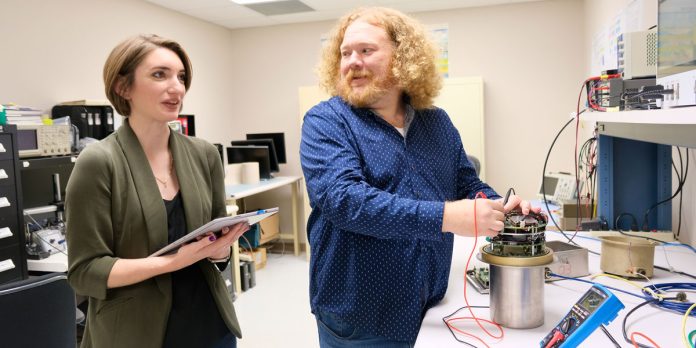HUNTSVILLE – Two researchers from the University of Alabama in Huntsville Earth System Science Center were recently awarded $402,000 from NASA’s 2022 Research Opportunities in Space and Earth Science to discover what aspects of lightning flashes are captured by NASA’s Lightning Imaging Sensor on the International Space Station and how these characteristics can provide information about how thunderstorms strengthen in intensity.
Over the three-year award period, UAH Research Associate Dr. Sarah Stough, principal investigator on the project; and co-investigators UAH Research Scientist Dr. Daniel Walker and NASA Marshall Space Flight Center Dr. Mason Quick will analyze the frequency and type of lightning emissions NASA’s space-based optical lightning sensors can detect.
By understanding atmospheric conditions that influence the initiation of a lightning flash from a storm cloud and determining the characteristics of lightning that are seen from space, Stough and Walker expressed this research will help influence how the next generation of NASA’s space-based lightning detection instrumentation is developed.
“Lightning emits radiation across the electromagnetic spectrum and can vary between storm classifications. Most of the time, we’re only seeing a small portion of the lightning spectrum from any one instrument,” says Walker.
The team will review lightning data from seven flights previously conducted during a collaborative field campaign in 2017. Instruments used to detect lightning flashes during this field campaign included NASA’s spaceborne optical Lightning Imaging Sensor on the International Space Station, NASA’s Fly’s Eye Geostationary Lightning Mapper Simulator aboard the NASA ER-2 aircraft and the NASA ground-based Lightning Mapping Array network.
Collecting lightning data from space down to the ground allows the team to generate a profile of lightning from cloud to ground produced by the observed thunderstorms.
“Having a complete picture of all the lightning emitted by the thunderstorms observed will allow our team to improve the diagnostic and predictive capabilities of space-based optical lightning detection by getting a better idea of how these instruments ‘see’ a lightning flash,” Stough notes.
Lightning is also tied to the updraft of a thunderstorm. As an updraft moves liquid water content into the colder regions of the cloud, it creates ice particles and helps to give ice in the storm cloud an electrical charge. Eventually, layers of negative and positive charges will develop within the cloud where a flash will initiate.
“Our project will also use radar data to help us measure the updraft and detect the ice content in the cloud associated with lightning flashes,” Stough states. “Once the flash initiates, we examine the characteristics of the storm that made it. Little flashes occur near more turbulent updrafts, while bigger flashes typically occur in calmer stratiform regions of a thunderstorm where a charge has been able to build for a longer time.”
Don’t miss out! Subscribe to our email newsletter to have all our smart stories delivered to your inbox.



